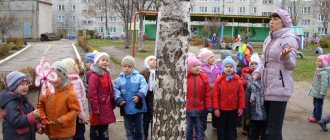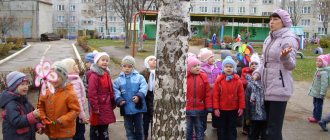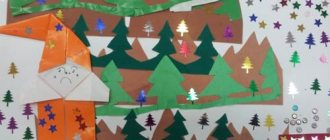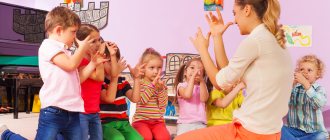Middle group. Junior preschool age. Children 4 - 5 years old
Summary of the lesson in the middle group “Inanimate nature: the sun, the month, the stars” Program content: To form in preschoolers an interest in the phenomena of inanimate nature: the sun, the month, the stars. Develop observation, visual and auditory attention. Encourage children to establish relationships between inanimate and living nature phenomena: spring. winter, summer, autumn. Enter...
Notes for a lesson on origami in the middle group "Journey into space" Notes for a lesson on origami in the middle group "Journey into space "
Integration of educational areas: social and communicative development, cognitive development, speech development, artistic and aesthetic development, physical development. Goal: To develop creative...
Summary of the OD lesson in the middle group “Space flight”
FCCM in the middle group "Space flight"
Goal: consolidating children's knowledge about space Objectives: Educational: • nurturing love for one's planet, • attentive attitude towards people, • pride in the achievements of one's people. Educational: • expand children’s ideas about the world around them (space), • introduce children to the concepts of “sun”, “moon”, “month”, “space”, “star”, “cosmonaut”, “space suit”, “rocket”; • form an initial idea of the Solar System. Developmental: formation in children of a holistic picture of the world, Develop cognitive activity and interest in understanding the world around them Integration of areas: • Cognition • Reading fiction • Physical education • Speech development • Artistic and aesthetic development Equipment and materials: • Globe • Space-themed photos • Puzzles on the topic: “Space” • Dienesh blocks
Progress of the lesson
(On two tables there are puzzles with images of space. The teacher invites the children to assemble them) Educator: Guys, what do you think we will talk about today Children: About space Educator: Do you know what Space is? (children's answers) Educator: Space is very high, where the Earth's airspace ends, outer space begins. Birds don't fly there. Planes cannot fly there. The sky there is completely black. There is no air in space. Guys, what is there in space? Let us solve the riddles: Peas are scattered across the dark sky, Colored caramel made from sugar crumbs, And only when the morning comes, All the caramel will suddenly melt. (Stars) In space, an object flies through the thickness of the Icy years. Its tail is a strip of light, And the object’s name is... (Comet) This bird has no wings But you can’t help but marvel Only when the bird spreads its tail And rises to the stars (Rocket) Educator: Guys, why do people need rockets?” (children's answers) Educator: People need this unique aircraft to explore space, other planets, and search for planets suitable for human habitation. (Showing photos of rockets) Educator: Guys, what is the name of the person who controls the rocket (cosmonaut). An astronaut has a special suit for space flights and this suit is called a spacesuit. (Showing an image of a spacesuit) A person needs a spacesuit for protection. Why does a person need protection in space? Educator: Two dogs were the first to fly into space: Belka and Strelka. Only after they returned safe and sound, Yuri Alekseevich Gagarin was able to go on a space journey and circle around our entire Earth. He made his flight on April 12, 1961 on a Vostok rocket. Since then, this day has been celebrated in our country and it is called Cosmonautics Day. (Showing a photo of Gagarin) Educator: Guys, now listen to a poem about Yu. Gagarin. In a space rocket with the name “Vostok” He was the first on the planet to rise to the stars. Spring Drops sings songs about this: Gagarin and April will be together forever. Educator: Guys, what do you need to do to become an astronaut? (children's answers) That's right, guys, you need to lead a healthy lifestyle, eat right, play sports, do well at school and college. Let us turn into cosmonauts - and repeat the feat of Yuri Gagarin and fly around our planet. So what will we use to fly into space, we don’t have a rocket? Let us build a rocket together. I offer you the material for its construction. (Children build a rocket from Dienesh blocks, space music sounds). Educator: Guys, imagine you are astronauts, but before you go on a flight, we need physical training. Fizminutka: We are going to the cosmodrome, We walk in step together. Children walk in a circle.
We walk on our toes, We walk on our toes.
We're walking on our heels. They walk on their heels.
Here they checked the posture. Stop facing in a circle, hands on the belt.
And the shoulder blades were brought together. The shoulders were turned, the shoulder blades were brought together.
Don't yawn around, you are an astronaut today! Turns the head left, right.
Educator: Guys, take your seats in the rocket, let's start the countdown: 5, 4, 3, 2, 1¬- START! Let's hold on tight until our rocket goes into outer space. Here we are in space. Let's look through our porthole. (Showing the globe) I see some kind of planet - this is the earth. Let's listen to the sounds of our earth from space. (Audio recording of nature sounds) Guys, why is our planet so blue. Children: There is a lot of water on it. Educator: What is special about our planet? Only on our planet do flowers grow, trees only on our planet there are animals and us. What other planets do you know? Children: Mars, Jupiter Educator: There are other planets in space. Listen to a poem about them: An astrologer lived on the moon. He kept track of the planets: One - Mercury, Two - Venus, Three - Earth, Four - Mars. Five is Jupiter, Six is Saturn, Seven is Uranus, Eight is Neptune. And behind it, then, is the ninth planet called Pluto. Educator: Guys, let's repeat the poem together and remember what planets there are. (Memorizing a poem) Educator: Oh oh oh, there’s some kind of gray ball there ahead. Guys, guess the riddle: At night I walk across the sky, Dimly illuminating the earth. It's boring, I'm bored alone, And my name is... (Moon) Educator: At what time of day do we see the moon? Guys, the moon is a satellite of the earth. The Moon has one wonderful feature: it changes its appearance every day. Either it appears like a narrow crescent, then it is called “the month” (showing a photo of the month), then it looks like a pancake, they say about it: “full moon” (showing a photo of the moon). It's getting too hot. Guess the riddle: A yellow plate hangs in the sky. The yellow plate gives everyone warmth. (Sun) Educator: Guys, we are flying past our sun. (Photo of the sun) Guys, what a sun (yellow, round like a ball, hot, if you fly too close you can burn). Well, it’s getting hotter and we need to return to our planet (as it’s called). (“We’re coming back” to the song from the cartoon “Smeshariki” “On a Round Planet”) Educator: Five, four, three, two, one - we’ve landed! Hooray! Did you enjoy our trip? Who can tell me what profession we met today? Children: Cosmonaut Educator: What holiday is celebrated in April? Children: Cosmonautics Day Educator: Well done! Now let's draw what we saw during our flight. (Drawing based on an individual plan.) Exhibition of works.
Abstract of OOD on the topic: Space for children of the middle group of preschool educational institutions
Types of activities for children: play, communication, cognitive, motor exploration, construction from various materials. Integration of educational spheres: social-communicative, cognitive, linguistic, artistic and aesthetic.
Goal: to expand children’s knowledge about space and space travel, develop children’s artistic creativity, interest in independent creative activity (graphic, constructive model), satisfy children’s needs for self-expression, develop skills of friendly communication and interaction with peers, evoke emotional pleasure in children from activities, activate children's fantasies, form elementary ideas about space and space, encourage active speech.
Preparatory work: training in finger gymnastics “The Stars Are Shining”, the physics protocol “Cosmonauts”; visualization of illustrations in space; conversation on the topic “Cosmonaut”; design made from rocket waste. Expected results: children show interest in creative activities, are kind to each other and to the teacher; have a basic understanding of space and space; actively express your thoughts through speech. Contents of organized children's events
1. Introduction to the game situation
Teacher: Guys, we have guests today. I have to say hello. I say hello everywhere - At home and on the street, Hello too, I say On the next street. Hello, blue sky, hello, golden sun, hello, light breeze, hello, oak tree, hello, morning, hello, day, took the time to say hello Teacher: Children, this morning I received an unusual email. Let's see together. Who knows what? Can we help him?
2. Discovery of new knowledge.
Spatial conversation teacher: Guys, look, this is a space model. And it seems to me that something is missing? What do you know? Children: Stars. Teacher: Okay, guys. Space is a world of stars, it is very diverse. The stars appear small because they are far away. In fact, stars are huge spheres of glowing gas, similar to the Sun. Take each of the stars, let's place them in our spatial diagram. What else is missing? Children of the Sun Teacher: Find the sun. See what a huge sun really is. And the stars seem very small in comparison. Guys, there are unusual balls near the sun. These are planets. I repeat... Nine planets revolve around the Sun, listen to their names: Mercury, Venus, Earth, Mars, Jupiter, Saturn, Uranus, Neptune, Pluto. Look at each planet, they are all different, very beautiful and unusual. Who knows what kind of planets these are? Teacher: What planet do we live on? Children: Earth Teacher: That's right, guys. Why is our planet Earth called the blue planet? Because most of our planet is covered with water: seas and oceans, rivers and lakes.
3. Didactic game “Rocket”.
A minute of physics “Cosmonauts”. Educator: Guys, I don’t know who knows nothing about space but really loves puzzles. But he can't solve the puzzle. Listen. This bird has no wings, but it’s impossible not to be surprised. As soon as the bird straightens its tail, it takes off towards the stars (rocket). Teacher: Guys, you are so experienced in space. I suggest you build a rocket to fly into space, I don’t know based on geometric shapes. Look, we have a model of a rocket. Let's try to build the same rockets. You are wonderful! Let's relax with you. Teacher: One or two, there is a rocket. (boy raises his hands) Three or four, go early. (spreads his arms to the sides) To fly towards the sun (circles his arms) Cosmonauts need a year. (He grabs his cheeks with his hands, shakes his head) But they are not afraid of the road (arms to the sides, body tilts left and right) Each of them is an athlete (bend your elbows) Flight over the ground (spread your arms to your sides) They will greet you. (raises hands and greets)
What else to read: Fun and exciting seated games for kids
4. Game “Put Dunno Flying”
Teacher: They built a rocket for Dunno, but forgot to pack his luggage. There is nothing superfluous or random in the spaceship. Therefore, during space travel we will take with us only the essentials. I will show you different objects, and you should clap your hands if this item is useful during travel, and hide your hands behind your back if this item is not needed (space suit, sled, bucket, first aid kit, flashlight, doll).
5. Free up space in the bank
Teacher: Guys, I don’t know, now you know a lot about space. And he is ready to become a real astronaut. You and I still don’t have the opportunity to fly into space, we are small. I invite you to create your own space. Bank space. Educator: To give your fingers a rest, let's do finger gymnastics. Stars are shining in the dark sky, an astronaut is flying on a rocket. The day flies and the night flies And looks at the ground. (Alternately connecting the thumb with the little finger, ring finger, middle finger and index finger on stressed syllables.) Children, take a closer look at the table. In front of everyone is an empty jar. I will tell you and show you how to make space in the jar. And you will do this to me. Deal with? Educator: To create space in the jar we will need: stars, cotton wool, a stick and two-color water. Take a cotton pad and divide it into two equal parts. We insert the part into our jar using a stick. Now we take the stars and put them in a jar on cotton wool. Very good. Fill the cotton pad and stars with water from the purple test tube. Now let's do the same. Take the remaining piece of cotton wool and carefully place it with a stick into the jar, put a few stars and fill it with blue water from the second test tube. We close our space well with a lid.
Over the Earth late at night, Just reach out, Grab the stars: they seem close. Teacher: See how well everything went? You are really smart.
6. Summary
Guys, look, another letter has arrived. We see?
I don’t know, he says thank you to us. Guys, what news did we learn today? What is the name of our planet? What is the name of the spacesuit? How many people want to be astronauts? Good guys, you were very careful during the lesson. You will become good astronauts.
Progress of the conversation:
Guys, have you ever looked at the sky? What did you see there?
People have been looking at the sky and admiring the stars for a long time. They are very
I'd be interested to know what they are. Do you want to know about the stars?
To learn about the stars, people built a space rocket . AND
dogs to be sent into were Belka and Strelka, and when they returned,
people also wanted to get closer to the stars. Next look at
Yu. A. Gagarin went to the stars - this is the first cosmonaut .
It's very, very cold in space If you go into space without
special suit - you can instantly freeze and turn into
ice. In addition, there is very little air in space and an ordinary person there
won't be able to breathe. That is why the astronaut who flew to
space , put on this spacesuit. The suit is very warm and protective
an astronaut from the cold even in space . In addition, there is a man in a spacesuit
can breathe - it supplies a person with air.
When the astronaut got into the rocket , the countdown began: “Five, four,
three, two, one, GO!” The rocket took off, fire came out of its tail - so
her engine was working hard. And the rocket flew high into the sky. She
rose higher and higher. And so the rocket ended up in outer space .
Look what the astronaut when he found himself in it.
This is our planet Earth - we live on it. As you can see, she
round and looks like a big ball. Our planet is very, very large.
That's why we don't notice that it looks like a ball. But if you rise above
the earth high, high - then from space we will see it like this
Look how beautiful our planet is!
What do you think is blue on our planet? (children's answers)
.
What's green? Brown? (children's answers)
Look, this is a small ball near the earth - the moon. Moon
much smaller than the earth and in space it also looks like a ball.
And this is how the astronauts saw our Sun. Huge
glowing fireball. But astronauts cannot
they could - because the Sun is very, very hot. If you get close to him
too close and you might even get burned.
And the astronauts saw other planets that were rotating
around the sun. Look, this picture shows all the planets,
which revolve around the Sun. Notice how huge our
Sun! It is larger than all other planets! And our planet Earth is
she is the third from the Sun - very small compared to others
planets. All planets in the solar system revolve around the sun
its orbit. On those planets that are very close to the Sun - very
hot! We couldn't have stayed there for even a second! And at the farthest
planets - which are far from the Sun - on the contrary, are very cold, because
the sun's rays do not reach there well.
In this picture you can see what different sizes there are.
planets and how big our Sun turns out to be. From the Earth the Sun to us
it doesn't seem that big because it is very far from us. Actually
in fact - that's how huge it is!
And around the planets the astronauts saw small luminous balls,
looking like little suns, they were stars. Let's go with you too
That's how many interesting things the astronauts learned about space .
Let's fly to the stars easily! Application It is no secret that preschool children find the theme “Space” extremely interesting. Before Cosmonautics Day, they get the opportunity to learn a lot.
Source
What to tell your child about space (middle group)
Lydia Kolobova
What to tell your child about space (middle group)
There are 8 planets in the solar system. They all revolve around the Sun, constantly along the same path, which is called an orbit. And one of these planets is our Earth. The sun is a large and very hot star, a huge, hot ball. It is very far away, but the heat from its rays reaches all the planets circling around it, and ours too. That's why it's warm here. The moon is a satellite of our planet; it is only three days away. The Moon moves around the Earth counterclockwise.
Our planet is surrounded by an atmosphere. This is a protective layer that saves inhabitants from solar ultraviolet radiation, as well as from most meteorites. It can be compared to a blanket of air. It is thanks to him that our planet has the air that we breathe.
It is believed that the rest of the space is lifeless. The belief and desire of people to find life on other planets forces us to design spaceships to travel into space in order to study it.
You can get creative with your children and make aliens.
There are only 8 planets in the solar system. The largest of them is Jupiter. And the most interesting is Saturn, because it has huge rings around it.
Jupiter, Uranus and Neptune also have rings, but they cannot be seen from Earth.
On April 12, our country celebrates Cosmonautics . On this day in 1961, people's dream of flying into space cosmonaut in history, Yuri Alekseevich Gagarin, flew into space on the Vostok-1 spacecraft. Its flight around the Earth lasted 108 minutes. Since then, every year on this day we celebrate Cosmonautics .
Let's make our own rockets!
Consultation “What to tell 6-7 year old children about space?” Space for preschool children, such an interesting topic. Let's try to tell children about space as clearly and interestingly as possible.What to tell children about Maslenitsa Maslenitsa is a cheerful and life-affirming holiday of seeing off winter and welcoming spring, which is celebrated with pleasure by both children and adults.
What to tell children about Maslenitsa! About Maslenitsa - for children Maslenitsa is one of the most fun holidays in Rus'. This is a kind of traditional cycle (lasting a week) of seeing off winter and...
Consultation “How to tell a child a fairy tale” A small child loves to listen to fairy tales. But it is much more interesting not only to read a fairy tale, but also to show illustrations to the fairy tale. Today there is.
Consultation for parents “October 20 is the day of the Primorsky Territory. What’s interesting to find out for yourself and tell to your child” Primorye - May’s small homeland October 20 Primorye Day What’s interesting to find out for yourself and tell to your child: LEGENDS AND TRADES OF PRIMORYE Legend.
Consultation for parents “May 9. How to tell your child about the Great Victory Day” Goal: Improving educational work; strengthening its patriotic orientation; formation of the foundations of the national.
Consultation for parents “What to tell your child about Maslenitsa” DEPARTMENT OF EDUCATION OF THE ADMINISTRATION OF THE CITY OF TYNDA MUNICIPAL PRE-SCHOOL EDUCATIONAL BUDGETARY INSTITUTION “KINDERGARTEN No. 6 “CHERYOMUSHKA”.
Consultation for parents “What to tell your child about Easter?” DEPARTMENT OF EDUCATION OF THE ADMINISTRATION OF THE CITY OF TYNDA MUNICIPAL PRE-SCHOOL EDUCATIONAL BUDGETARY INSTITUTION “KINDERGARTEN No. 6 “CHERYOMUSHKA”.
Consultation “Non-childish conversations: how to tell a child about death?” Non-childish conversations: how to tell a child about death? In every family, sooner or later there comes a time when the child begins to ask questions.
Thematic conversation “Man in Space” for children of senior preschool age (secondary and preparatory groups) Goal: to expand and deepen preschoolers’ knowledge about space. Objectives: to consolidate children's knowledge that the first person to fly into space.
Source




